Improved Interface Circuit for Enhancing the Power Output of a Vibration-Threshold-Triggered Piezoelectric Energy Harvester
Abstract
:1. Introduction
2. Vibration-Threshold-Triggered Piezoelectric Energy Harvester
2.1. Structure and Operating Principles of the Vibration-Threshold-Triggered Energy Harvester
2.2. Modeling of the Vibration-Threshold-Triggered Energy Harvester
2.2.1. Vibration Model
2.2.2. Equivalent Circuit Model
2.3. Parameter Calculation of Vibration Model
2.4. Impedance Characteristics of the Vibration-Threshold-Triggered Energy Harvester
3. Interface Circuit of the Vibration-Threshold-Triggered Energy Harvester
3.1. Standard Energy-Harvesting Interface Circuit
3.2. Improved Energy-Harvesting Interface Circuit
4. Experimental Results
5. Discussion and Conclusions
Author Contributions
Funding
Conflicts of Interest
References
- Xi, Y.; Guo, H.; Zi, Y.; Li, X.; Wang, J.; Deng, J.; Wang, Z.L. Multifunctional TENG for blue energy scavenging and self-powered wind-speed sensor. Adv. Energy Mater. 2017, 7, 1602397. [Google Scholar] [CrossRef]
- Lee, W.K.; Schubert, M.J.W.; Ooi, B.Y.; Ho, S.J.Q. Multi-source energy harvesting and storage for floating wireless sensor network nodes with long range communication capability. IEEE Trans. Ind. Appl. 2018, 54, 2606–2615. [Google Scholar] [CrossRef]
- Wang, H.; Jasim, A.; Chen, X. Energy harvesting technologies in roadway and bridge for different applications–A comprehensive review. Appl. Energy 2018, 212, 1083–1094. [Google Scholar] [CrossRef]
- Narita, F.; Fox, M. A review on piezoelectric, magnetostrictive, and magnetoelectric materials and device technologies for energy harvesting applications. Adv. Eng. Mater. 2018, 20, 1700743. [Google Scholar] [CrossRef] [Green Version]
- Suzuki, Y.; Miki, D.; Edamoto, M.; Honzumi, M. A MEMS electret generator with electrostatic levitation for vibration-driven energy-harvesting applications. J. Micromech. Microeng. 2010, 20, 104002. [Google Scholar] [CrossRef]
- Roundy, S.; Wright, P.K. A piezoelectric vibration based generator for wireless electronics. Smart Mater. Struct. 2004, 13, 1131–1142. [Google Scholar] [CrossRef] [Green Version]
- Wook, K.; Divij, B.; Shinkyu, J.; Dukhyun, C. Mechanical energy conversion systems for triboelectric nanogenerators: Kinematic and vibrational designs. Nano Energy 2019, 56, 307–321. [Google Scholar] [CrossRef]
- Ylli, K.; Hoffmann, D.; Willmann, A.; Becker, P.; Folkmer, B.; Manoli, Y. Energy harvesting from human motion: Exploiting swing and shock excitations. Smart Mater. Struct. 2015, 24, 025029. [Google Scholar] [CrossRef]
- Ju, S.; Ji, C.H. Impact-based piezoelectric vibration energy harvester. Appl. Energy 2018, 214, 139–151. [Google Scholar] [CrossRef]
- Guan, M.; Liao, W.H. Design and analysis of a piezoelectric energy harvester for rotational motion system. Energy Convers. Manag. 2016, 111, 239–244. [Google Scholar] [CrossRef]
- Kamel, T.M.; Elfrink, R.; Renaud, M.; Hohlfeld, D.; Goedbloed, M.; De Nooijer, C.; Jambunathan, M.; Van Schaijk, R. Modeling and characterization of MEMS-based piezoelectric harvesting devices. J. Micromech. Microeng. 2010, 20, 105023. [Google Scholar] [CrossRef]
- Tang, G.; Liu, J.; Yang, B.; Luo, J.-B.; Liu, H.; Li, Y.-G.; Yang, C.-S.; He, D.; Dao, D.V.; Tanaka, K.; et al. Fabrication and analysis of high-performance piezoelectric MEMS generators. J. Micromech. Microeng. 2012, 22, 065017. [Google Scholar] [CrossRef]
- Yang, Z.; Zhou, S.; Zu, J.; Inman, D. High-performance piezoelectric energy harvesters and their applications. Joule 2018, 2, 642–697. [Google Scholar] [CrossRef] [Green Version]
- Safaei, M.; Sodano, H.A.; Anton, S.R. A review of energy harvesting using piezoelectric materials: State-of-the-art a decade later (2008–2018). Smart Mater. Struct. 2019, 28, 113001. [Google Scholar] [CrossRef]
- Fan, K.; Tan, Q.; Zhang, Y.; Liu, S.; Cai, M.; Zhu, Y. A monostable piezoelectric energy harvester for broadband low-level excitations. Appl. Phys. Lett. 2018, 112, 123901. [Google Scholar] [CrossRef]
- Zhang, J.; Qin, L. A tunable frequency up-conversion wideband piezoelectric vibration energy harvester for low-frequency variable environment using a novel impact-and rope-driven hybrid mechanism. Appl. Energy 2019, 240, 26–34. [Google Scholar] [CrossRef]
- Tang, Q.; He, Q.; Li, M.; Dong, C.; Xu, D.; Li, X. Wireless alarm microsystem self-powered by vibration-threshold-triggered energy harvester. IEEE Trans. Ind. Electron. 2016, 63, 2447–2456. [Google Scholar] [CrossRef]
- He, Q.; Dong, C.; Li, K.; Wang, J.; Xu, D.; Li, X. A multiple energy-harvester combination for pattern-recognizable power-free wireless sensing to vibration event. Sens. Actuator A-Phys. 2018, 279, 229–239. [Google Scholar] [CrossRef]
- Badel, A.; Guyomar, D.; Lefeuvre, E.; Richard, C. Efficiency enhancement of a piezoelectric energy harvesting device in pulsed operation by synchronous charge inversion. J. Intell. Mater. Syst. Struct. 2005, 16, 889–901. [Google Scholar] [CrossRef]
- Lefeuvre, E.; Badel, A.; Richard, C.; Guyomar, D. Piezoelectric energy harvesting device optimization by synchronous electric charge extraction. J. Intell. Mater. Syst. Struct. 2005, 16, 865–876. [Google Scholar] [CrossRef]
- Du, S.; Amaratunga, G.A.J.; Seshia, A.A. A cold-startup SSHI rectifier for piezoelectric energy harvesters with increased open-circuit voltage. IEEE Trans. Power Electron. 2018, 34, 263–274. [Google Scholar] [CrossRef]
- Kwon, S.C.; Onoda, J.; Oh, H.U. Performance evaluation of a novel piezoelectric-based high-frequency surge-inducing synchronized switching strategy for micro-scale energy harvesting. Mech. Syst. Signal Proc. 2019, 117, 361–382. [Google Scholar] [CrossRef]
- Morel, A.; Gasnier, P.; Wanderoild, Y.; Pillonnet, G.; Badel, A. Short circuit synchronous electric charge extraction (SC-SECE) strategy for wideband vibration energy harvesting. In Proceedings of the IEEE International Symposium on Circuits and Systems (ISCAS), Florence, Italy, 27–30 May 2018. [Google Scholar] [CrossRef] [Green Version]
- Shi, G.; Xia, Y.; Wang, X.; Qian, L.; Ye, Y.; Li, Q. An efficient self-powered piezoelectric energy harvesting CMOS interface circuit based on synchronous charge extraction technique. IEEE Trans. Circuits Syst. I-Regul. Pap. 2018, 65, 804–817. [Google Scholar] [CrossRef]
- Chen, N.; Wei, T.; Jung, H.J.; Lee, S. Quick self-start and minimum power-loss management circuit for impact-type micro wind piezoelectric energy harvesters. Sens. Actuator A-Phys. 2017, 263, 23–29. [Google Scholar] [CrossRef]
- Chen, N.; Jung, H.J.; Jabbar, H.; Sung, T.H.; Wei, T. A piezoelectric impact-induced vibration cantilever energy harvester from speed bump with a low-power power management circuit. Sens. Actuator A-Phys. 2017, 254, 134–144. [Google Scholar] [CrossRef]
- Chen, N.; Wei, T.; Ha, D.S.; Jung, H.J.; Lee, S. Alternating resistive impedance matching for an impact-type microwind piezoelectric energy harvester. IEEE Trans. Ind. Electron. 2018, 65, 7374–7382. [Google Scholar] [CrossRef]
- Bao, M. Analysis and Design Principles of MEMS Devices; Elsevier: London, UK, 2005. [Google Scholar]
- Hobeck, J.D.; Inman, D.J. A distributed parameter electromechanical and statistical model for energy harvesting from turbulence-induced vibration. Smart Mater. Struct. 2014, 23, 115003. [Google Scholar] [CrossRef]
- Elvin, N.G.; Elvin, A.A. A general equivalent circuit model for piezoelectric generators. J. Intell. Mater. Syst. Struct. 2009, 20, 3–9. [Google Scholar] [CrossRef]
- Erturk, A.; Inman, D.J. A distributed parameter electromechanical model for cantilevered piezoelectric energy harvesters. Trans. ASME. J. Vib. Acoust. 2008, 130, 041002. [Google Scholar] [CrossRef]
- Akoun, G.; Yonnet, J.P. 3D analytical calculation of the forces exerted between two cuboidal magnets. IEEE Trans. Magn. 1984, 20, 1962–1964. [Google Scholar] [CrossRef]
- Kong, N.A.; Ha, D.S.; Erturk, A.; Inman, D.J. Resistive impedance matching circuit for piezoelectric energy harvesting. J. Intell. Mater. Syst. Struct. 2010, 21, 1293–1302. [Google Scholar] [CrossRef]



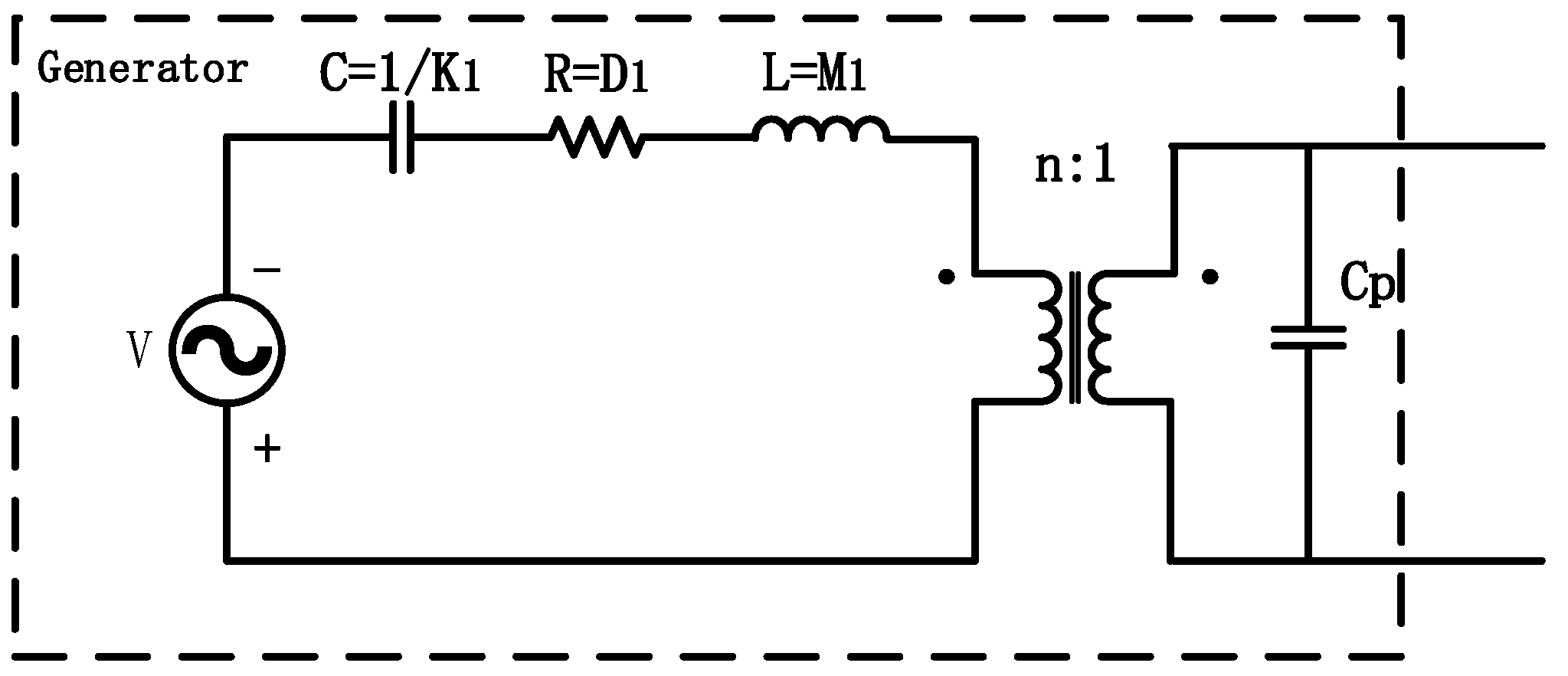

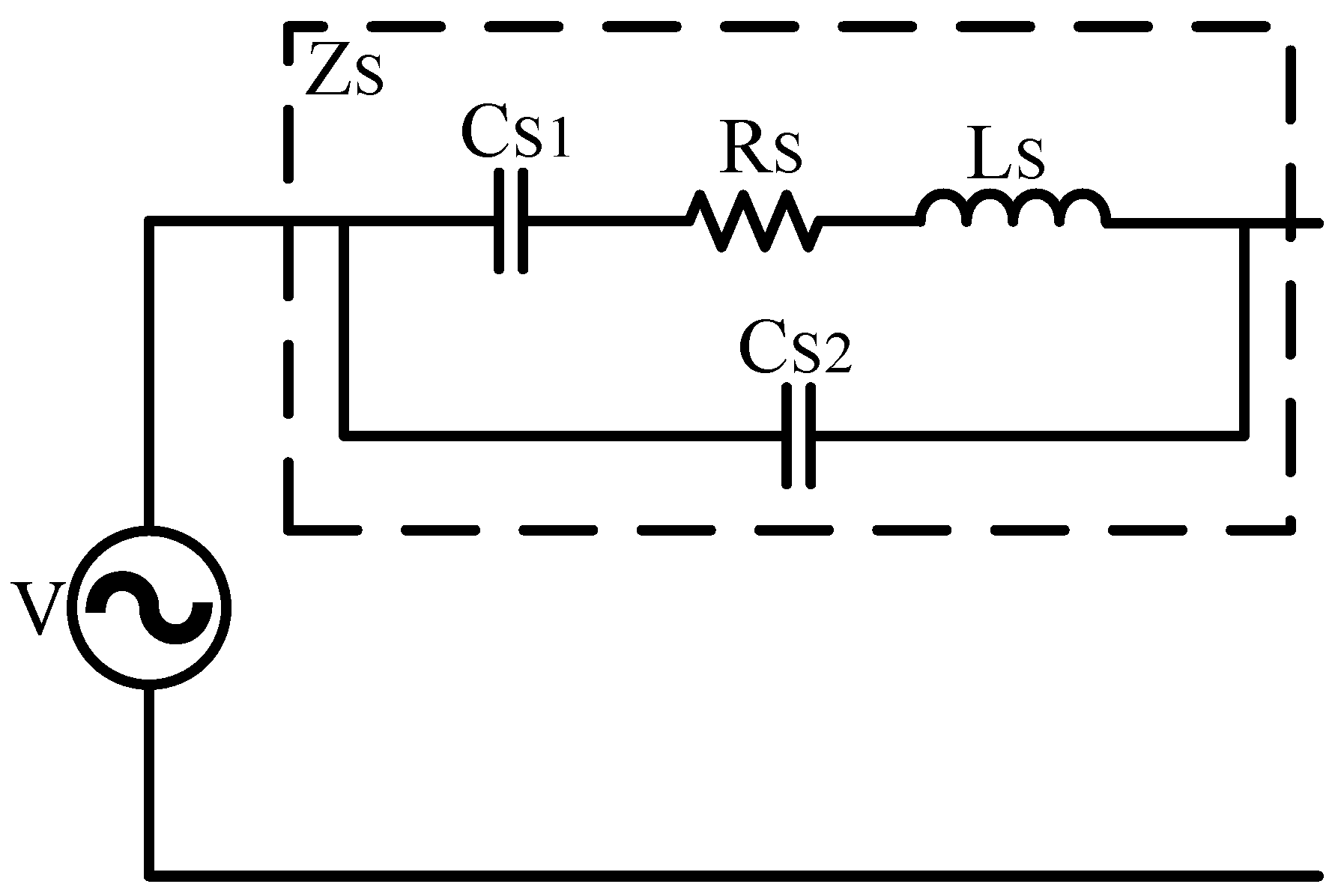

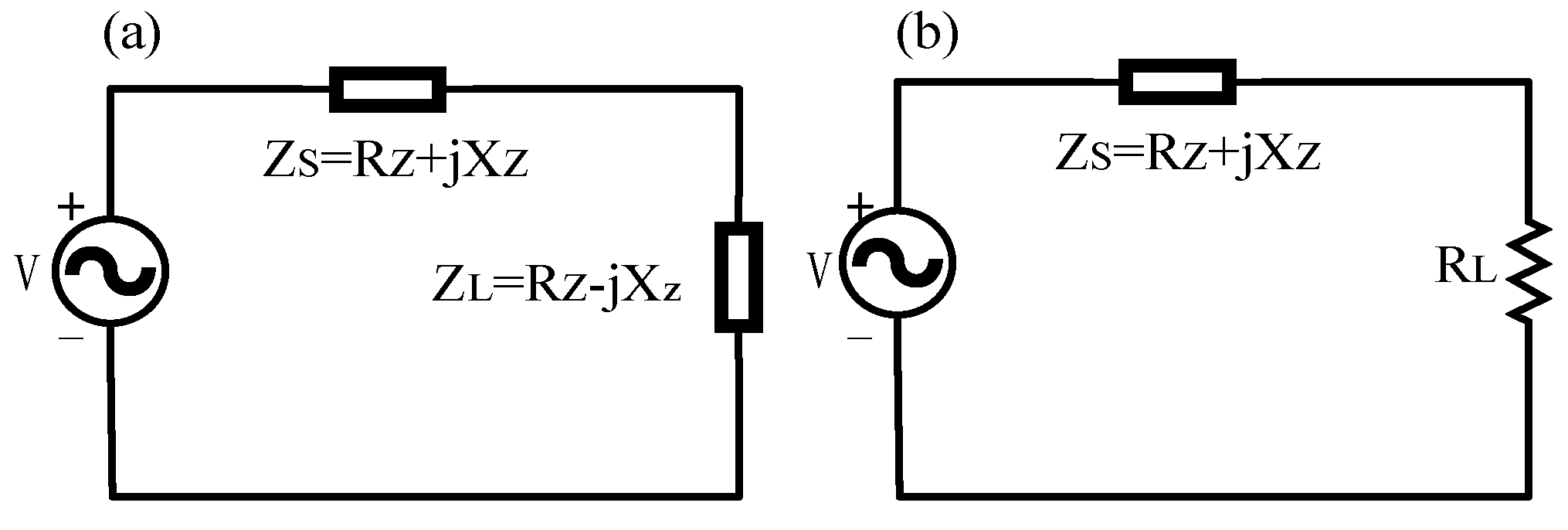


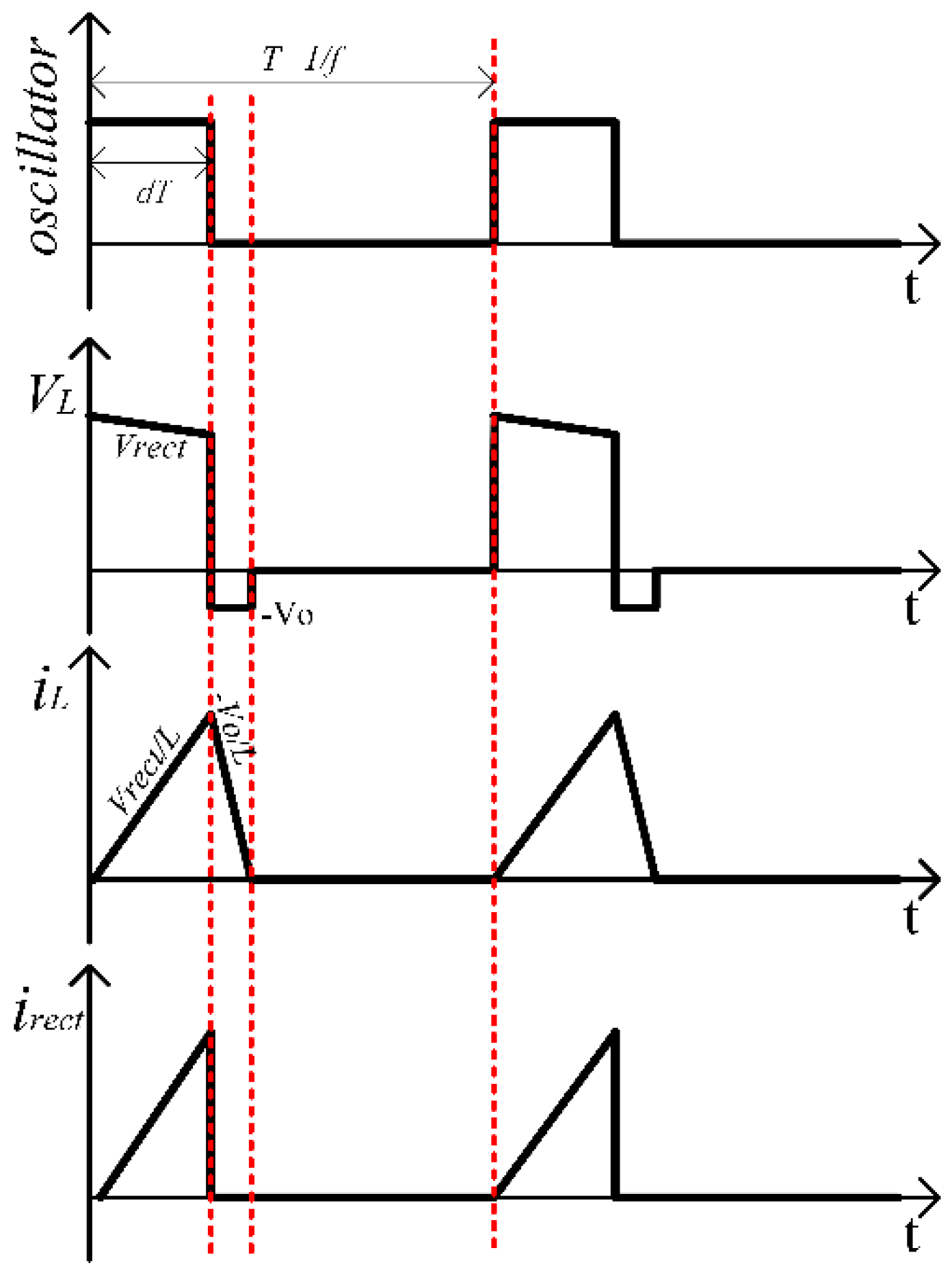
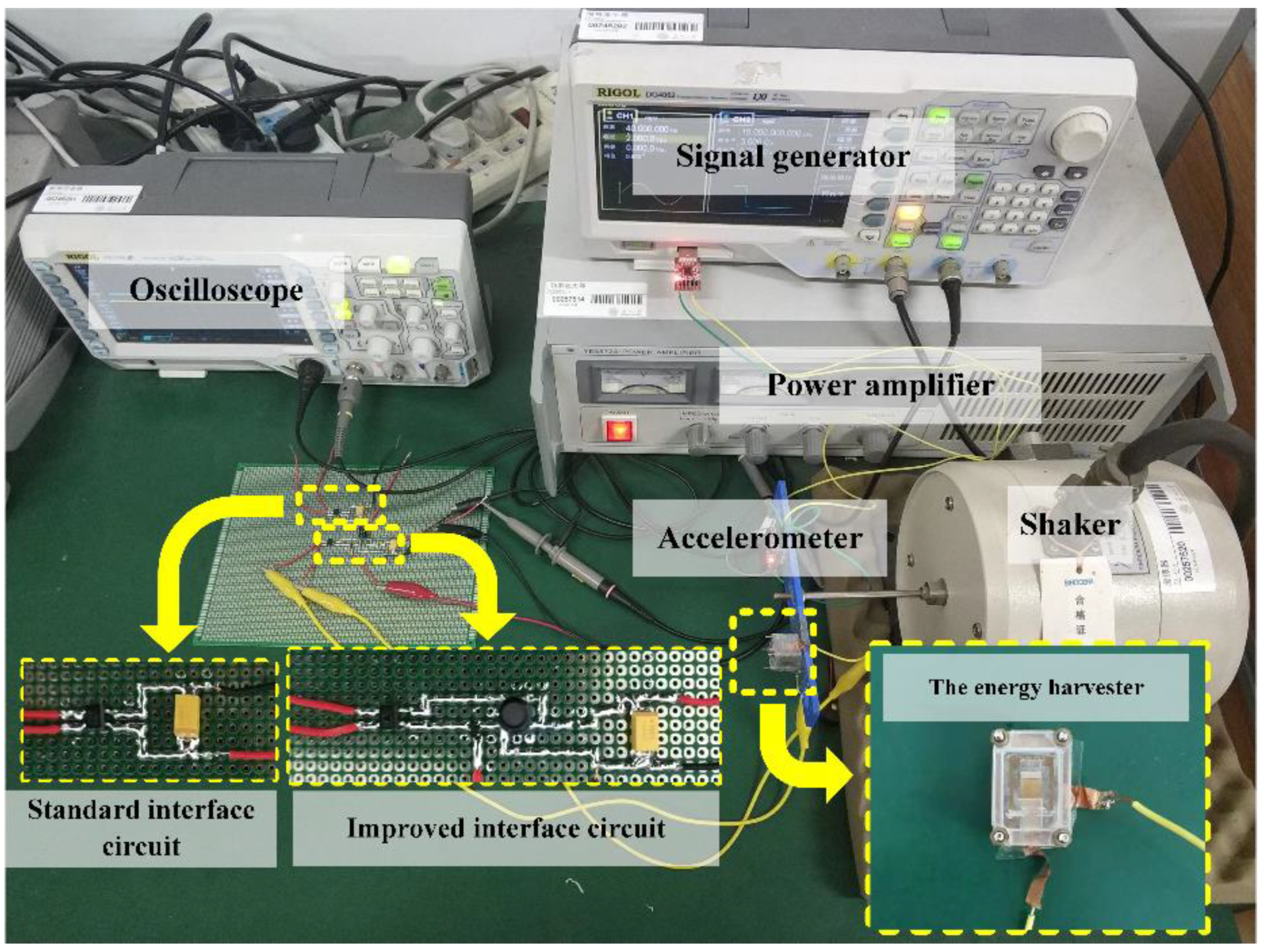



| Parameter | Symbol | Value |
|---|---|---|
| Thickness of sensing stage | hs | 100 µm |
| Length of sensing stage | Ls | 13.0 mm |
| Mass of sensing stage | m | 0.93 g |
| Width of sensing stage | bs | 8.0 mm |
| Thickness of generating stage | hg | 60 µm |
| Length of generating stage | Lg | 11.0 mm |
| Width of generating stage | bg | 4.0 mm |
| Length of PZT | Lp | 5.5 mm |
| Thickness of PZT | hp | 60 µm |
| Young’s modulus of substrate | Ys | 110 Gp |
| Young’s modulus of PZT | Yp | 60 Gp |
| Density of substrate | ρs | 8800 kg/m3 |
| Density of PZT | ρp | 7500 kg/m3 |
| Damping constants | α0 | 4.894 |
| α1 | 1.235 × 10−5 | |
| Piezoelectric coupling | d31 | 280 × 10−12 m/V |
| Relative electrical permittivity | ε | 4600 |
| Gap distance | G | 750 µm |
| Residual magnetism | Br | 1.0 T |
| 298.962 | 5.359 × 10−5 | 0.003 | 7.030 × 10−4 | 1.679 × 10−8 |
| Components | Part Number | Notes |
|---|---|---|
| Rectifier bridge | MB6S | VFmax = 1.0 V |
| MOSFET | SI2302 | VGS(th) = 1.2 V; RDS(on) = 55 mΩ |
| Inductor L | - | 47 mH |
| Diode D | BAT54L | VF = 0.4 V at 10 mA |
| Capacitor C1,C2 | AVX Tantalum capacitor | 100 μF |
| Oscillator | Generated by the signal generator | VM = 3 V; f = 15 kHz; d = 22% |
| Frequency | Average Energy-Harvesting Power (μW) | Percentage Energy Increase (%) | |
|---|---|---|---|
| Standard Interface Circuit | Improved Interface Circuit | ||
| 20 Hz | 7.1 | 10.8 | 52.1 |
| 30 Hz | 15.6 | 23.1 | 48.1 |
| 40 Hz | 62.5 | 102.0 | 55.7 |
© 2020 by the authors. Licensee MDPI, Basel, Switzerland. This article is an open access article distributed under the terms and conditions of the Creative Commons Attribution (CC BY) license (http://creativecommons.org/licenses/by/4.0/).
Share and Cite
Liu, J.; Yang, J.; Han, R.; He, Q.; Xu, D.; Li, X. Improved Interface Circuit for Enhancing the Power Output of a Vibration-Threshold-Triggered Piezoelectric Energy Harvester. Energies 2020, 13, 3830. https://doi.org/10.3390/en13153830
Liu J, Yang J, Han R, He Q, Xu D, Li X. Improved Interface Circuit for Enhancing the Power Output of a Vibration-Threshold-Triggered Piezoelectric Energy Harvester. Energies. 2020; 13(15):3830. https://doi.org/10.3390/en13153830
Chicago/Turabian StyleLiu, Jiqiang, Junjie Yang, Ruofeng Han, Qisheng He, Dacheng Xu, and Xinxin Li. 2020. "Improved Interface Circuit for Enhancing the Power Output of a Vibration-Threshold-Triggered Piezoelectric Energy Harvester" Energies 13, no. 15: 3830. https://doi.org/10.3390/en13153830





